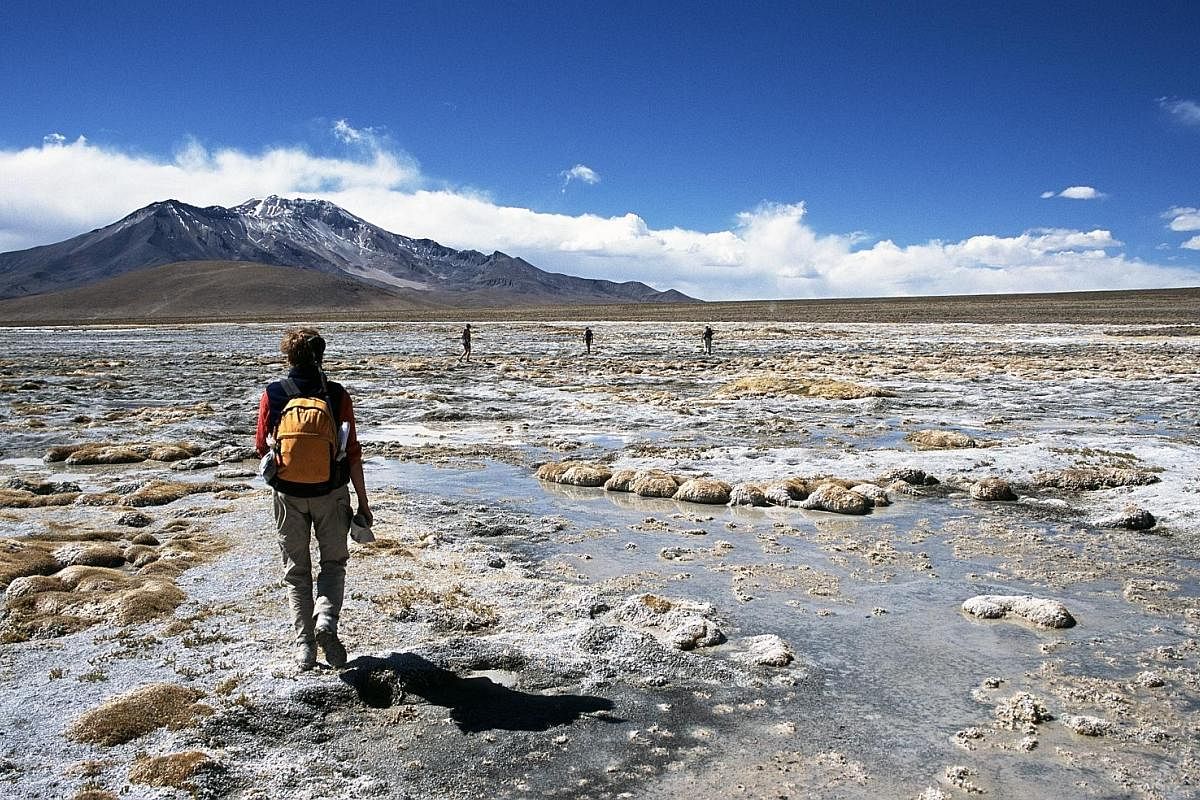-
GETTING THERE
-
From Singapore, fly to Sydney, then take a direct Qantas flight to Santiago, a service that operates thrice weekly. From Santiago, fly Latam or Sky Airlines to Antofagasta or Arica, where you can rent a car to get around.
-
TIPS
-
• There is little humidity in Chile. It is dry the whole year round. Even when it gets hot and is over 30 deg C in summer, it will still be cool in the shade.
• To make the most of your time in Chile and spend some time in the north and south, you will need at least 10 days, and three more days if you want to go to Easter Island.
• It is safe for travellers to rent a car in Chile if they have an international driver's licence. The roads are good and it is easy to get around and navigate on your own or with GPS.
• Because of the country's geography, travellers will immediately have a sense of where they are. The Andes mountains are always in the east and the sea is in the west. Just remember to fill up your tank whenever you can.
• Chile is a safe country, though there are some areas where it is better not to go late at night. If using public transportation, beware of pickpockets, who will take your bag, phone or wallet and are good at identifying tourists.
• People may be surprised by the good humour and friendliness of Chileans. If they see you are lost, they will stop and help you, always with a smile.
Travel Black Book: Ambassadors series
Atacama Desert in northern Chile: Life on Earth's driest desert
The best of home: Ambassadors to Singapore provide an insider's guide to their favourite destinations


Who: Mr James Sinclair, in his 60s, Ambassador of Chile to Singapore
Favourite destination: Atacama Desert in northern Chile. From north to south, Chile is 4,270km long and an average of 180km wide, forming a thin, but geographically diverse country on the western coast of South America.
From vineyards and mountains in the centre to beautiful fjords and glaciers in the south, the landscape sometimes reminds one of Europe.
But in the north, it is different. There, in the Atacama Desert, the driest desert on Earth, you will find villages that were developed by the Incan empire, beautiful valleys and rocky salt flats and the most incredible night skies full of stars.
SEE
Arica is a beautiful seaside resort town in northernmost Chile, less than 20km from the Peruvian border. Here, you will find some of the best beaches in Chile. The temperature of the water is very agreeable here because it is north of the Humboldt current, which brings freezing water up the coast from Antarctica and makes the ocean too cold to swim further south.
Visit the Museo Arqueologico San Miguel de Azapa (masma.uta.cl), a museum housing mummies of the ancient Chinchorro people that is located a few kilometres outside town.
The Chinchorro lived in this region from around 7000 to 1500 BC. The mummies are thousands of years old. The world's oldest mummy, dating back to around 7020 BC, was found in the Atacama Desert and is more than 4,000 years older than the earliest Egyptian mummy, which is dated to around 3000 BC.
Arica is an ideal base from which to explore the Azapa Valley, a rare oasis in the desert where locals are able to grow fruit and vegetables year round. It is famous for olives that grow to the size of plums, are violet in colour and bitter in flavour, and produce a strong tasting oil.
Then head east to Lauca National Park (http://bit.ly/2szWwv3) for breathtaking scenery, snow- capped volcanoes, hot springs and unique animals such as the rabbit-like viscacha. It is located 3,000m to 6,300m above sea level, near the Bolivian border.
Next, travel about 600km south of Arica to the small beautiful towns of San Francisco de Chiu Chiu and San Pedro de Atacama. This area is the high central desert and has incredible rocky landscapes that look like the moon in some places and Mars in others.
It has not rained here in more than 400 years, yet there are small village communities surviving around small rivers or oases with llamas and alpacas, living in the traditional way as they have for thousands of years.
Most people use San Pedro de Atacama as their base to explore the region's natural highlights, including the lunar landscape of El Valle de la Luna (Valley of the Moon), hiking around the Cerro Toco volcano, visiting the salt flats and El Tatio Geysers, which are magnificent at sunrise, and marvelling at the mirror-like Cejar Lagoon at sunset.
If you like astronomy, the Atacama Desert is a must-visit. At more than 2,500m above sea level and with no lights around, it is the best place in the world for stargazing. It never rains, so you are guaranteed the most pristine skies ever.
Some of the world's most important observatories are built here, including Alma (www.almaobservatory.org), the largest land-based observatory ever built. More powerful than the Hubble telescope, its 66 giant antennas capture signals from faraway galaxies and new-born stars. On Saturday and Sunday mornings, visitors who book well in advance can tour the facilities.
EAT
In the north, people typically have a light breakfast of fruit, juice, bread, cheese and maybe some scrambled eggs, with coffee or tea.
We take coffee seriously in Chile. There are great cafes in every city, serving Italian-style espresso with a cornetto (a croissant-like breakfast pastry).
We also eat a lot of seafood from the Pacific Ocean. Sea urchins are abundant all along the coast and we also have beautiful sea scallops and abalone, tuna, mahi mahi and Chilean sea bass. They are grilled or served fresh from the ocean as ceviche with lemon, olive oil, salt, chilli, coriander and red onion.
Chile is also known for its wines, which were brought over by the Spanish in the 16th century. With many different terroirs, Chilean vineyards can grow many varieties of grapes.
Grapes are also the source of pisco, Chile's national drink. It is made from the moscatel grape grown in the north. Pisco sours are often served with limon de Pica, a type of small green lemon, which is juicy and aromatic, with a thin peel.
For dessert, don't miss the Torta San Guillermo, a cake of ice cream topped with a layer of meringue, then dried fruit and a caramel or custard sauce made with amaretto, grappa or Grand Marnier. It is typically a dessert on winter menus.
PLAY
Close to San Pedro de Atacama, in the next valley, there is a small town called La Tirana where they prepare a big colourful festival in honour of the Virgin del Carmen. Every year in July, the townspeople dress up in costumes and masks as angels, monsters and devils, then parade and dance for days to expel the demons from their town.
SHOP
A bottle of wine or pisco is a natural memento of Chile. You can buy a good bottle of wine for $20 to $50.
For something special, look for jewellery made with lapis lazuli, a deep-blue semi-precious stone that is found in the Andes mountains.
STAY
Hotel Explora Atacama (http://bit.ly/2siCpOP), located on 17ha of land outside San Pedro de Atacama, is a five-star, all-inclusive resort.
Its tours take you to see the natural and cultural sites of the region on foot, bicycle and horseback. The 50-room hotel in the desert also has its own observatory, so guests can enjoy unparalleled views of the night sky. A stay here is more than US$1,000 (S$1,383) a night.
I also recommend Alto Atacama Desert Lodge & Spa (www.altoatacama.com/en) in a valley just outside San Pedro de Atacama.
The hotel has been designed to blend into the landscape and is modelled after the architecture of local villages. Rooms start at US$700 a night.
Join ST's Telegram channel and get the latest breaking news delivered to you.
A version of this article appeared in the print edition of The Sunday Times on June 18, 2017, with the headline Atacama Desert in northern Chile: Life on Earth's driest desert. Subscribe


